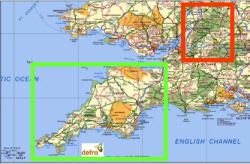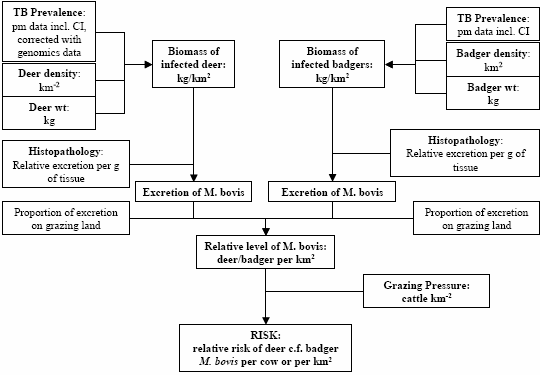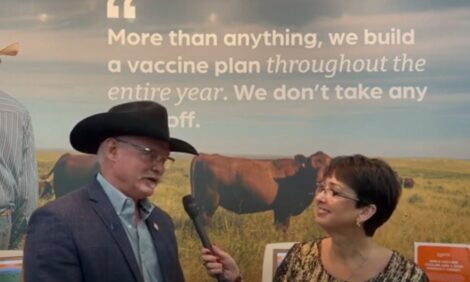



Bovine TB: Tracking the Footprints from Deer to Cattle
It has been known for some time that many species of wild deer can carry and transmit Bovine Tuberculosis, but limited research has kept scientists in the dark on the prevalence of these incidents and how they can affect cattle populations, writes Adam Anson, reporting for TheCattleSite.Bovine Tuberculosis is a serious issue for cattle producers worldwide. In the UK alone 3,005 incidents of Bovine TB were confirmed between January and September 2008. Over 37,000 herds were tested, totalling 4,218,826 animals - a costly side affect of the diseases presence.
* "It would seem prudent to take steps to prevent populations of these species from achieving these conditions, rather than attempting to re-dress the situation once it becomes a problem." |
|
|
As a result there has been a long standing debate on the huge economic toll that badgers infected with the disease have on the industry. In hot contention is the issue of a wide scale badger cull which aims to eliminate current TB hot spots. Recently the UK government backed-down on this proposal due to a series of campaigns highlighting the unethical issues of a cull whilst adding that previous culls have been ineffective and costly.
Despite of the media attention focused on badgers as TB reservoirs, there has been little attention given to the possible affects that infected deer populations are having.
Whether these wildlife reservoirs contribute to the perpetuation of the disease in cattle is likely to depend on whether they can maintain infection independently within their populations, how far they may carry infection during natural movements, whether they are capable of excreting bacteria into the environment, at a sufficient dose, and whether cattle are likely to come into contact with them and/or their infectious products in such a way as to facilitate disease transmission.
According to the Department for Environment, Food and Rural Affairs (Defra), in 2007 Delahay et al. carried out surveys of bTB infection in wild mammal carcasses collected from cattle bTB hotspots in southwest England and used these prevalence estimates in combination with published information on the behaviour and ecology of each species to assess the potential risks of onward transmission to cattle.
The results suggested that red deer (Cervus elaphus) and fallow deer (Dama dama) in particular could potentially be implicated. However, while this was a useful first-step in understanding the role of other wildlife species in perpetuating bTB in cattle, the risk assessment procedure was simplistic and only semi-quantitative.
Getting a Closer Look with Two More Steps

As a result of this apparent knowledge gap Defra recently initiated and published two reports to further investigate the affects that deer were having. The South-west England and Cotswolds Survey of Tuberculosis in Deerformed by Andrew Patterson provided indicative values for the prevalence of bTB in all deer species found in areas of high bTB prevalence in cattle.
The areas chosen for the survey were three large estates in the Cotswolds, together with all the areas of the public forest estate land in the Forestry Commission's South-West Peninsula District (Somerset, Devon and Cornwall). The results indicated that on the public forest estate land in the South-West peninsula, bTB is present at a very low level (less than 1 per cent, except in one area where it is present at 3.8 per cent in fallow deer).
In the Cotswolds, high prevalence was found in two of the three areas sampled (15.9 per cent and 8.1 per cent), particularly in fallow deer, where the prevalence was as high as 26 per cent in one population. Fallow deer were identified as the most likely of all the species of deer to be infected with M. bovis.
Despite of these results the report acknowledged that on their own, these data cannot predict the role that deer may play in the current epidemic of bTB in cattle.
In a second investigation, entitled: Exposure of Cattle to Mycobacterium Bovis Excreted by Deer in Southwest England: a Quantitative Risk Assessment, the Central Science Laboratory recently constructed a risk model to characterise exposure of cattle to M. bovis excreted by four species of deer and badgers onto pasture. Using expert opinion and empirical measurements the risk scores were made relative to the badger.
The team also constructed a bTB host status model to predict the likely host status (spill-over or maintenance) of each of the four species of deer and badgers across a range of densities.
The results showed that Median risk scores were below those of the badger, but upper 95th percentiles exceeded unity for all four deer species. The findings reasoned that throughout most of southwest England and Wales, deer are likely to pose less of a risk to cattle than do badgers.
The report also stated that among the wild deer species, red and fallow deer certainly present bTB pathology consistent with onward transmission of M. bovis.

These results are largely due to ecological differences between the species, which influence the nature and frequency of contact with cattle. 'For example, fallow deer use pasture more than do roe deer or muntjac. Moreover, behaviour and ecology probably influence the likelihood of bTB perpetuation within a population of deer', says the report. 'Fallow and red deer are more likely to exist in large herds than are roe deer and muntjac, and maintenance of M. bovis within a population and independently of external sources, is more likely among large, free-mixing herds, than among less gregarious, territorial populations, due to lower intraspecific contact rates.'
A Round Up of the Results
Summarising its findings, the report said: 'We consider it unlikely that reductions in deer density or abundance would reduce bTB prevalence among infected deer herds in most circumstances experienced in southwest England and Wales, because they most probably act as spillover hosts throughout most of their ranges where they are infected. Consequently, they probably acquire most M. bovis infection from external sources, which would seem more appropriate targets for bTB control efforts. Moreover, reduction of deer populations could not be expected to contribute substantially to bTB exposure risks posed by wildlife to cattle, since these risks may be driven mainly by badgers.'
However, it added that in some deer species, notably fallow deer and possibly muntjac and red deer, have the potential to become maintenance hosts of M. bovis. 'It would seem prudent to take steps to prevent populations of these species from achieving these conditions, rather than attempting to re-dress the situation once it becomes a problem', concluded the report.
Further Reading
| - | Find out more information on Bovine Tuberculosis by clicking here. |
January 2009


